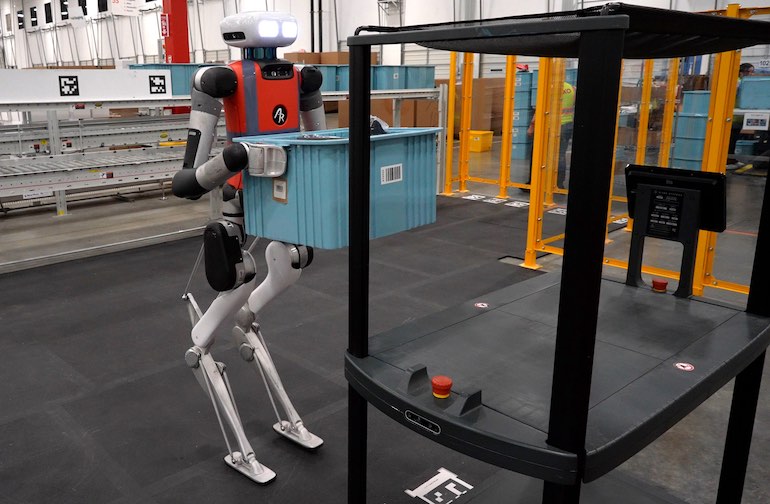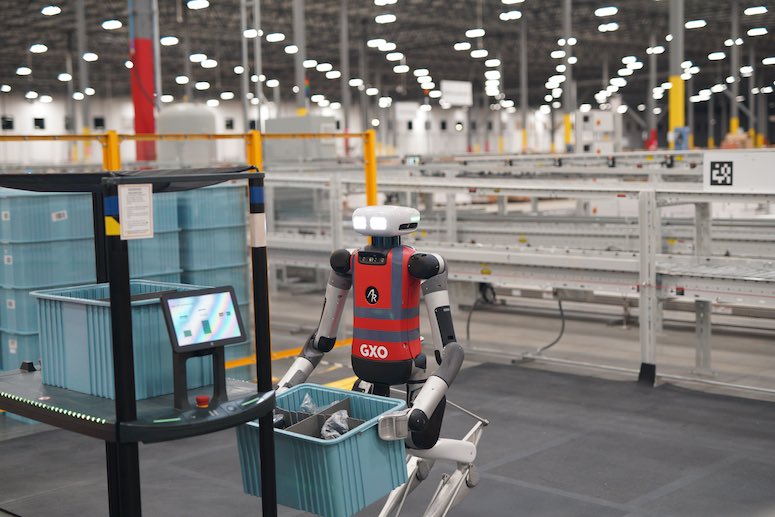|
Listen to this article  |
You can add the world’s largest pure-play contract logistics provider to the growing list of companies testing Agility Robotics’ Digit humanoid. GXO Logistics is conducting a proof-of-concept pilot with Digit at Spanx’s facility in Flowery Branch, Ga.
Adrian Stoch, GXO‘s chief automation officer, told The Robot Report Spanx is one of its customers willing to test the limits of innovation with robotics. And the global womenswear brand is doing just that with Digit.
In the pilot, Digit is moving totes off of autonomous mobile robots (AMRs) and onto a conveyor. The AMRs, which appear to be Chucks from 6 River Systems, bring the packed totes to a transfer station. Digit then uses its perception system to detect the AMR has arrived. Digit then picks up a tote off the top or bottom shelf, carries it over and places it onto the conveyor. In the future, Agility said Digit will also communicate directly with the AMR fleet manager.
Now, this tote-moving task seems similar to how Amazon is testing Digit. Amazon’s initial use for Digit is to recycle empty totes. It takes totes off a stationary storage rack and carries them to a conveyor. However, there are at least a couple of important differences to point out with Spanx.
First, the totes are filled with products. When asked how much an average tote filled with Spanx products weighs, Agility Robotics co-founder and CEO Damion Shelton ballparked it to be between 5-10 lbs. Digit, which is 5’9″ tall and weighs 140 pounds, can lift up to 35 lbs. Second, Digit interacts with an AMR. I don’t think I’ve ever seen a humanoid collaborate with an AMR before.
“Digit can work with the AMR similar to how a human does,” said Shelton. “Anyone getting a Spanx shipment within the last couple weeks may have had Digit help pack their product.”
How Digit can help
If this initial phase is successful, GXO said it will pilot Digit in a variety of other roles in 2024. Based in Greenwich, Connecticut, GXO manages more than 970 supply chain facilities around the world totaling approximately 200 million square feet. So how can Digit prove its worth?
“There are two criteria,” Stoch said GXO is evaluating. “The first is the maturity of the technology. It needs to learn from our teachings and move product as our business needs it to. Once we prove that, the second part is economics. It doesn’t need to be a significant financial business case because of the safety benefits [Digit brings to the facility].”

Digit is moving full totes from mobile robots to a conveyor at Spanx’s warehouse in Georgia. | Credit: Agility Robotics
During her recent appearance on The Robot Report Podcast, Agility Robotics CTO Melonee Wise, who spent years developing wheeled, mobile robots, said humanoids can help connect “islands of automation.” Stoch echoed that sentiment, adding that Digit’s potential flexibility gives it a nod over an AMR with a top module.
“The real application here is end-to-end product flow throughout the warehouse,” Stoch said. “Until now, solutions have been mostly discrete applications: goods-to-person, sorters, wearable tech. Solving discrete problems in one part of the puzzle.
“We have 12-15 sites with highly integrated, end-to-end flows that require heavy human interaction between the different areas. What we’ve got here with Digit is a great first application: cobot to robot to conveyor. It’s lifting totes that have been packed, organized, put onto mobile robots.
 Submit your nominations for innovation awards in the 2024 RBR50 awards.
Submit your nominations for innovation awards in the 2024 RBR50 awards.
“A lot of customers have dynamic environments, and it’s hard to predict what volumes will be during peak season, let alone Q2 next year. How much volume will we receive in the different parts of the warehouse? That’s where having flexibility is critical. Even if that is predictable, we can potentially have Digit support the e-commerce side of the business on Black Friday and then have it walk to another part of the warehouse on any given day.”
Humanoids getting their feet wet
Robots are in high demand within logistics thanks to labor shortages, increasing demand, and other challenges. Until recently, however, humanoids had not been considered a viable option for warehouse operators. There are still many naysayers.
It seems a new humanoid is revealed every month now. Apptronik, Figure, Fourier Intelligence, Sanctuary, Tesla, and Unitree are just are few of the companies working on commercializing humanoids. Now China wants in on the action, saying it’ll mass produce humanoids by 2025.

Digit bends down to take a tote off the bottom shelf of a mobile robot. | Credit: Agility Robotics
For the time being, Agility Robotics has two legs up on the competition. Regardless of whether you think humanoids are viable, those working in robotics shouldn’t underestimate what Agility Robotics has already accomplished; having Amazon and GXO test a humanoid is no small feat.
“We don’t have control over the floor finish or the lighting [at the Spanx warehouse],” Shelton said. “The rubber on Digit’s feet or its vision system are things you can truly only learn about when on-site with customers. This is the continued evolution of our system.”
Agility recently unveiled RoboFab, a robot manufacturing facility in Salem, Oregon with the capability to produce more than 10,000 robots per year.
“The last couple of months have been the first time we’ve been able to talk publicly about our pilots. We’re excited as it’s the culmination of what we’ve been working on. Shipping something in high volume makes you relevant, not a footnote in history.”
“It’s hard for us to get excited until we realize [Digit] is a surprise to everyone else,” said Jonathan Hurst, co-founder and chief robot officer, of Agility Robotics. “We’ve been working on this for so long, we knew this was coming. But to share it with customers is very exciting. And this is just the beginning.”
Credit: Source link


Comments are closed.